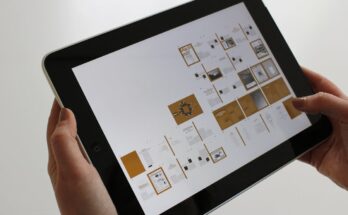Hey there! Ever feel like technology is moving at warp speed, and it’s tough to keep up with what’s next? You’re not alone! Gadgets and software seem to change the world every few months, and staying on top of it all can feel like trying to drink from a firehose. Maybe you’re just super curious about what the future holds, or perhaps you’re wondering how all this new stuff might actually impact your job, your home, or even just how you spend your free time.
Well, if you’re itching to know what’s right around the corner, you’ve come to the right place. We’re gonna pull back the curtain a bit and look at 10 cutting-edge tech trends that are shaping up to be a big deal in 2025. We’ll break down what they are, why they matter, and give you some real-world (or future-world!) examples so it all makes sense. By the time you finish reading, you’ll have a much clearer picture of where tech is headed and feel a little more ready for what’s next.
AI Gets More Like Having a Smart Sidekick
Okay, first up, you’ve heard of AI, right? Like Siri or Alexa, or maybe the tools that can write stories or make pictures now? In 2025, expect AI to get way smarter and pop up in even more places, almost like having a helpful sidekick that knows your routine.
Think about those AI tools that write or create stuff. They’re getting seriously good, not just spitting out facts but understanding context and even having a bit of a style. This is called Generative AI, and it’s gonna be everywhere. Maybe your computer helps you brainstorm ideas for a project, or a design tool suggests layout changes you hadn’t thought of. Picture this: You’re trying to plan a surprise birthday party for a friend. Instead of just searching for “party ideas,” you might tell an AI assistant about your friend’s favorite things, where you plan to have it, and your budget. The AI could then whip up a full plan – theme suggestions, a simple guest list based on your contacts, even draft invitation wording and suggest decorations you can buy online. It’s taking helpfulness to a whole new level.
Beyond just creating things, AI is also becoming more of an “agent.” These are AIs designed to actually *do* tasks for you, sometimes without you even asking directly every step of the way. Imagine you’re trying to book a trip. Instead of you clicking through a bunch of websites, you might just tell your AI agent, “Find me a flight to see my grandparents next month, sometime around the 15th, and a place to stay that’s not too far from their house.” The AI goes off, compares prices, checks dates, maybe even factors in your past travel preferences, and presents you with the best options, or even just books it after a quick confirmation. It’s like having a really efficient personal assistant for your digital life.
Your World Gets Smarter, Really Smart
We already have smart speakers and thermostats, but get ready for the whole environment around you to become way more aware and helpful. This trend is sometimes called “Ambient Computing” or just a super-powered version of the “Internet of Things.” It means everyday objects will be packed with tiny computers and sensors, all talking to each other and to you.
Think about your home. In 2025, it won’t just be smart lights. Your fridge might track what’s inside and suggest recipes or remind you to buy milk. Your pantry could automatically reorder snacks when you’re running low. Floors might detect if someone falls. Windows could adjust tint based on the sun’s glare. Consider this scenario: You wake up, and as your feet hit the floor, the lights in the bedroom gently come on, the bathroom fan starts, and the coffee maker downstairs begins brewing your usual cup, all because the house knows your routine and sensed you’re up. It’s about technology fading into the background, just making things work smoothly and automatically based on what you’re doing and where you are.
Robots That Work Beside You
When you think of robots, maybe you picture big machines on a factory line or vacuum cleaners zipping around. The next wave of robots in 2025 is gonna be more about collaboration and having robots that are more flexible and helpful in everyday places, not just manufacturing plants.
These aren’t sci-fi helpers yet, but they’re getting better at doing tasks alongside humans. In warehouses, they might sort packages or move heavy boxes, freeing up people for more complex jobs. In restaurants, maybe a robot helps prepare simple parts of a dish or delivers food to tables. Picture a small, wheeled robot in a hospital delivering medicine or supplies, navigating busy hallways on its own. Or imagine a construction site where a robotic arm helps lift and place heavy beams safely, guided by a human worker. They’re designed to be more aware of their surroundings and work safely near people, making tasks easier and sometimes less dangerous.
Stepping Into Digital Worlds (or Blending Them)
Virtual Reality (VR) and Augmented Reality (AR) have been around, but they’re getting way more sophisticated and easier to use. This is often called “Spatial Computing” because it’s about technology that understands and interacts with the actual space around you.
VR, where you put on a headset and are completely immersed in a digital world, is getting higher resolution and more realistic tracking, making experiences feel more convincing. This isn’t just for gaming anymore. Imagine training simulations for jobs that are too dangerous or expensive to practice in real life, like being a surgeon or a pilot. Or think about attending a virtual class or meeting where you feel like you’re actually in the room with other people, even if they’re across the globe.
AR, which overlays digital stuff onto your real world (like seeing Pokémon appear in your park through your phone screen), is also evolving. Future AR glasses or even just better phone apps will make digital information feel more integrated. Think about walking down the street and seeing directions overlaid onto the pavement, or pointing your phone at a restaurant and instantly seeing its menu and reviews pop up. Maybe you’re trying to assemble furniture, and the instructions appear as glowing arrows and diagrams layered right onto the pieces in front of you, showing you exactly what goes where. It’s about blurring the lines between the digital and physical worlds in helpful ways.
Tech Helping Our Planet
As we get more techy, we’re also getting smarter about how to make technology part of the solution for things like climate change. “Sustainable Tech” or “Greentech” is a growing trend focused on using technology to be more energy efficient, reduce waste, and find cleaner ways to do things.
This involves better batteries for electric vehicles and storing renewable energy, smart grids that manage electricity flow more efficiently, and new ways to capture carbon from the air. It also means using AI to predict environmental changes or optimize resource use in industries like farming. Consider a farm using sensors and AI to figure out *exactly* how much water each part of a field needs, watering only when and where necessary, saving huge amounts of water. Or imagine buildings using smart systems that automatically adjust heating, cooling, and lighting based on who’s in the room and what the weather’s like outside, drastically cutting down energy waste. It’s about using innovation to build a greener future.
Healthcare Gets More Personal
Technology is changing how we think about staying healthy and treating sickness, making it much more personal and preventative. AI and data are playing a huge role here.
We’re seeing advances in personalized medicine, where treatments are tailored specifically to a person’s genetic makeup or unique health profile, rather than a one-size-fits-all approach. AI can help doctors analyze huge amounts of medical data, spot patterns, and even help detect diseases like cancer earlier and more accurately than the human eye alone. Imagine getting a health wearable that doesn’t just count steps, but uses AI to analyze your sleep patterns, heart rate, and other data to give you personalized advice on how to improve your well-being, or even alert you to potential health issues *before* you feel sick. Or think about doctors using VR to practice complex surgeries or using robotic tools for more precise procedures. It’s about using tech to understand our bodies better and treat health challenges in smarter, more targeted ways.
Computers That Are Way Different
This one feels a bit like science fiction, but it’s a real thing happening: Quantum Computing. Regular computers use bits that are either a 0 or a 1. Quantum computers use “qubits” which can be 0, 1, or *both* at the same time. This might sound weird, but it means they can potentially solve certain types of problems that are practically impossible for even the most powerful supercomputers today.
We’re still in the early days, but by 2025, we might start seeing some practical applications emerge from these strange machines. What kind of problems? Things like discovering new materials for batteries or solar panels, creating new medicines by simulating molecules, or breaking today’s toughest encryption codes. It’s not something you’ll have on your desk, but it could power breakthroughs in science, medicine, and security that affect everyone. Think of it as unlocking a whole new level of computing power that tackles challenges we couldn’t even dream of solving before.
So, there you have it – a peek into some of the coolest tech trends likely to make waves in 2025. From AI becoming your everyday helper to your home anticipating your needs, and from stepping into digital worlds to using tech to help the planet and our health, the future is shaping up to be pretty exciting. Technology isn’t slowing down; it’s just getting smarter and more integrated into our lives in ways we’re only starting to imagine.
Understanding these trends isn’t just about being in the know; it’s about being prepared. It helps you see how things around you might change, what new tools might become available, and even what kinds of jobs might be important down the line. The key takeaway is that tech isn’t just about gadgets anymore; it’s about creating a world that’s more intuitive, more efficient, and hopefully, better for everyone. Keeping an eye on these developments means you’re ready to ride the wave, not get swept away by it. The adventure continues!




